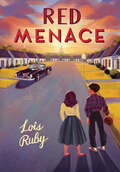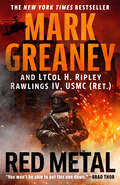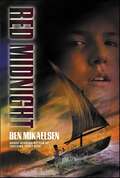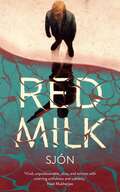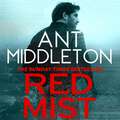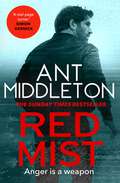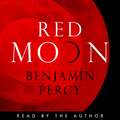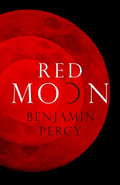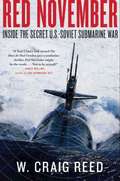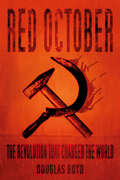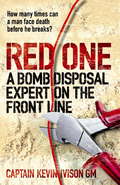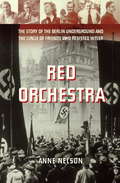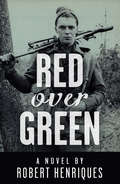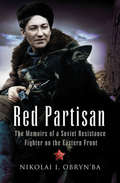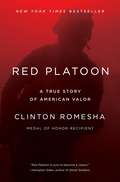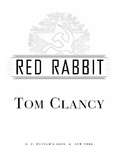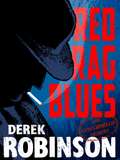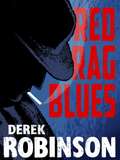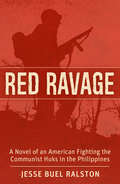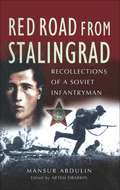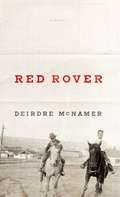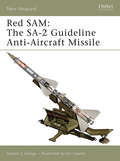- Table View
- List View
Red Menace
by Lois RubyA suspenseful and heartfelt story about an era whose uncertainties, controversies, and dangers will seem anything but distant to contemporary readers. If thirteen-year-old Marty Rafner had his way, he'd spend the summer of 1953 warming the bench for his baseball team, listening to Yankees games on the radio, and avoiding preparations for his bar mitzvah. Instead, he has to deal with FBI agents staking out his house because his parents—professors at the local college—are suspected communist sympathizers. Marty knows what happens to communists, or Reds, as his friends call them: They lose their jobs, get deported...or worse. Two people he's actually met, Julius and Ethel Rosenberg, have been convicted of being communist spies, and they're slated to be executed in two months. Marty just wants everything to go back to normal, but that's impossible thanks to the rumors that his parents are traitors. As his friends and teammates turn on him and federal agents track his every move, Marty isn't sure what to believe. Is his family really part of a Red Menace working against the United States? And even if they're simply patriotic Americans who refuse to be bullied by the government, what will it cost them? As the countdown to the Rosenbergs' execution date continues, it may be up to Marty to make sure his family survives.
Red Metal
by Mark Greaney H. RawlingsA Russian military strike against Europe could change the balance of power in the West. A stunningly realistic view of modern warfare from a battlefield commander and the New York Times bestselling author of The Gray Man. <P><P>The Russian bear has awakened. Their tanks race across Poland crushing all opposition on a headlong dash for the heart of Germany. Satellite killing missiles blind American forces while Spetznatz teams destroy Allied communications relays. It's all part of a master plan to confuse and defeat America and her allies. <P><P>Ranged against the Russian attack are a Marine lieutenant colonel pulled out of a cushy job at the Pentagon and thrown into the fray, a French Special Forces captain and his intelligence operative father, a young Polish female partisan fighter, an A-10 Warthog pilot, and the captain of an American tank platoon who, along with a German sergeant, struggle to keep a small group of American and German tanks in the fight. <P><P>Operation Red Metal is a nightmare scenario made real but could it just be the first move on the Russian chessboard? <P><b>A New York Times Bestseller</b>
Red Midnight
by Ben MikaelsenWhen guerrilla soldiers strike Santiago's village, they destroy everything in their path -- including his home and family. Santiago and his four-year-old sister escape, running for their lives. But the only way they can be truly safe is to leave Guatemala behind forever. So Santiago and Angelina set sail in a sea kayak their Uncle Ramos built while dreaming of his own escape. Sailing through narrow channels guarded by soldiers, shark-infested waters, and days of painful heat and raging storms, Santiago and Angelina face an almost impossible voyage hundreds of miles across the open ocean, heading for the hope of a new life in the United States.
Red Milk
by Sjón'A book like a blade of light, searching out and illuminating the darkest corners of history . . . It's vivid, unputdownable, alive, and written with unerring artfulness and subtlety.' Neel MukherjeeGunnar Kampen grows up in Iceland during the Second World War in a household fiercely opposed to Hitler and Nazism. At nineteen he seems set for a conventional, dutiful life. And yet in the spring of 1958, he founds a covert, anti-Semitic nationalist party, a cause that will take him on a clandestine mission to England from which he never returns. Inspired by one of the ringleaders of a little-known neo-Nazi group that was formed in Iceland in the 1950s, Sjón's portrait of an ardent fascist is as thought-provoking as it is disturbing. As this taut and fascinating novel suggests, the seeds of extremism can be hard to detect - and the ideology of the far-right remains dangerously potent.
Red Mist: The ultra-authentic and gripping action thriller (Mallory)
by Ant MiddletonMALLORY IS BACKYou've heard his true story - now go deeper into Ant Middleton's world with his ultra-authentic thriller series.Hiding out in a small village in France, ex-Special Forces veteran turned vigilante Mallory is trying to keep out of trouble, aware that there is a darkness within him that seeks out trouble - that enjoys it.But one night in a bar he meets an old man afraid for his granddaughter, worried about the young man with whom she's become involved.Unable to resist the pull of action, and of helping a family in need, Mallory is quickly drawn into a turf war that it will take all his special skills to survive.The Sunday Times-bestselling book one in the Mallory series, Cold Justice, is available now.Rave reviews for Ant Middleton's Mallory thrillers'Cold Justice is filled with thrilling details and insights that can come only from experience. A white-knuckler' Gregg Hurwitz'A pressure cooker of thrills, excitement and fear... the literary equivalent of Alton Towers'Mark Dawson'A gritty, hard-hitting debut thriller'Sun'An impressive debut thriller . . . Ant Middleton is sure to make a huge impact'Sunday Express'A smart, taut and hard-hitting thriller that grabbed me from the first page and held on tight until the end'Giles Kristian'An authentic white-knuckle ride so immersive it will leave readers gasping for breath'Daily Record'The details convince, the plot works and the pace is satisfactorily fast'Literary Review'It's a two-fisted hard-as-nuts thriller . . . A page-ripping treat'Evening Telegraph
Red Mist: The ultra-authentic and gripping action thriller (Mallory)
by Ant MiddletonMALLORY IS BACKYou've heard his true story - now go deeper into Ant Middleton's world with his ultra-authentic thriller series.Hiding out in a small village in France, ex-Special Forces veteran turned vigilante Mallory is trying to keep out of trouble, aware that there is a darkness within him that seeks out trouble - that enjoys it.But one night in a bar he meets an old man afraid for his granddaughter, worried about the young man with whom she's become involved.Unable to resist the pull of action, and of helping a family in need, Mallory is quickly drawn into a turf war that it will take all his special skills to survive.The Sunday Times-bestselling book one in the Mallory series, Cold Justice, is available now.Rave reviews for Ant Middleton's Mallory thrillers'Cold Justice is filled with thrilling details and insights that can come only from experience. A white-knuckler' Gregg Hurwitz'A pressure cooker of thrills, excitement and fear... the literary equivalent of Alton Towers'Mark Dawson'A gritty, hard-hitting debut thriller'Sun'An impressive debut thriller . . . Ant Middleton is sure to make a huge impact'Sunday Express'A smart, taut and hard-hitting thriller that grabbed me from the first page and held on tight until the end'Giles Kristian'An authentic white-knuckle ride so immersive it will leave readers gasping for breath'Daily Record'The details convince, the plot works and the pace is satisfactorily fast'Literary Review'It's a two-fisted hard-as-nuts thriller . . . A page-ripping treat'Evening Telegraph
Red Moon
by Benjamin PercyEvery teenage girl thinks she's different. When government agents kick down Claire Forrester's front door and murder her parents, Claire realises just how different she is.Patrick Gamble was nothing special until the day he got on a plane and, hours later, stepped off it, the only passenger left alive. A hero. President Chase Williams has sworn to eradicate the menace. Unknown to the electorate, however, he is becoming the very thing he has sworn to destroy. Each of them is caught up in a war that so far has been controlled with laws and violence and drugs. But an uprising is about to leave them damaged, lost, and tied to one another for ever.The night of the red moon is coming, when an unrecognizable world will emerge, and the battle for humanity will begin.(P)2013 Hachette Book Group
Red Moon: A Novel
by Benjamin Percy*Benjamin Percy's brand new speculative thriller, The Ninth Metal, is available to pre-order now*Every teenage girl thinks she's different. When government agents kick down Claire Forrester's front door and murder her parents, Claire realises just how different she is.Patrick Gamble was nothing special until the day he got on a plane and, hours later, stepped off it, the only passenger left alive. A hero. President Chase Williams has vowed to eradicate the menace. Unknown to the electorate, however, he is becoming the very thing he has sworn to destroy. Each of them is caught up in a war that so far has been controlled with laws and violence and drugs. But an uprising is about to leave them damaged, lost, and tied to one another for ever.The night of the red moon is coming, when an unrecognizable world will emerge, and the battle for humanity will begin.
Red November: Inside the Secret U.s.-Soviet Submarine War
by W. Craig ReedFew know how close the world has come to annihilation better than the warriors who served America during the tense, forty-six-year struggle known as the Cold War. Yet for decades their work has remained shrouded in secrecy. Now, in this riveting new history, W. Craig Reed, a former U.S. Navy diver and fast-attack submariner, provides an eye-opening, pulse-pounding narrative of the underwater struggles and espionage operations between the United States and the former Union of Soviet Socialist Republics that brought us to the brink of nuclear war several times. Red November is filled with new revelations and never-before-reported stories that take you deep beneath the surface and into the action during the entire Cold War period from 1945 through 1992. Reed served aboard submarines involved in espionage operations, and his father was a top naval intelligence specialist intimately involved in the Cuban Missile Crisis. Reed is one of the first authors to obtain in-depth interviews with dozens of navy divers, espionage operatives, submariners, and government officials on both sides (including several Soviet submarine captains), who describe the most daring and decorated missions of the conflict, including the top-secret Ivy Bells, Boresight, Bulls Eye, and Holystone operations. Other events, whose full details have not been made public until now, include: The harrowing underwater cat-and-mouse chase in October 1962 that almost resulted in the firing of nuclear-tipped torpedoes by Soviet Foxtrot subs and could have started World War III The alarming collision between the submarine USS Drum and a Soviet Victor III-class sub (an incident the author experienced firsthand), the American boat's remarkable escape, and the all-out effort by enemy forces to hunt her down in 1981 The role the author's father played in developing a highly classified, state-of-the-art system for detecting enemy subs that was instrumental in helping President Kennedy force Premier Khrushchev to back down at the height of the Cuban Missile Crisis And the storm and resulting engine failure that trapped the USS Seawolf on the sea bottom during an espionage mission in Soviet waters that nearly took the lives of 190 sailors in 1981 Transcending traditional submarine, espionage, and Cold War accounts with its level of detail and first-person perspective, Red November is an up-close examination of one of the most dangerous periods in world history and an intimate look at the lives of those who participated in our country's longest and most expensive underwater war.
Red October: The Revolution that Changed the World
by Douglas BoydThe October Revolution happened in November 1917. Later Soviet propaganda pretended for several decades that it was ‘the will of the people’, but in reality the brutal rebellion, which killed millions and raised the numerically tiny Bolshevik Party to power, was made possible by massive injections of German money laundered through a Swedish bank. The so-called ‘workers’ and peasants’ revolution’ had a cast of millions, of which the three stars were neither workers nor peasants. Nor were they Russian. Josef V. Djugashvili – Stalin – was a Georgian who never did speak perfect Russian; Leiba Bronstein – Trotsky – was a Jewish Ukrainian; Vladimir I. Ulyanov – Lenin – was a mixture of Tatar and other Asiatic bloodlines. Karl Marx had thought that the Communist revolution would happen in an industrialised country like Germany. Instead, German cash enabled Lenin, Trotsky, Stalin and Co. to destroy ineffective tsarist rule and declare war on the whole world. This is how they did it, told largely in the words of people who were there.
Red One: A Bomb Disposal Expert on the Front Line
by Kevin IvisonThe gripping true story of bomb disposal work that won Ivison a George Medal - and started a living nightmare...When two of his colleagues are killed by a roadside bomb in Iraq, young bomb disposal officer Kevin Ivison is called in to defuse a second even deadlier bomb just a hundred yards from the bodies of his friends. To make things worse, the entire area is under fire from snipers, and a crowd of angry Iraqis have begun to hurl petrol bombs...With little chance of living through this impossible task, Kevin leaves final messages for his loved ones and sets out alone towards the bomb that he is sure will be the last thing he sees. In this gut-wrenching and terrifying true story of heroism and survival, Kevin Ivison explains why he chose to be a bomb disposal expert in the first place, how he found the courage to face his death, and the unendurable stress that has given him nightmares ever since.
Red One: The bestselling true story of a bomb disposal expert on the front line in Iraq
by Captain Kevin IvisonThe British Hurt Locker. In the Iraq War, Cpt Kevin Ivison defused bombs and IEDs left by the Taliban. Each time he took the 'longest walk' to a bomb, it could have been his last. How many times can a man stare death in the face before he breaks? Even the most skilful operators can only roll the dice so many times before they get unlucky . . . This was my bomb, my task and my fate alone. There was nothing left to do but walk.When two of his colleagues are killed by a roadside bomb in Iraq, young bomb disposal officer Kevin Ivison is called in to defuse a second, even deadlier bomb just a hundred yards from the bodies of his friends. To make things worse, the entire area is under fire from snipers, and a crowd of angry Iraqis have begun to hurl petrol bombs...With little chance of living through this impossible task, Kevin leaves final messages for his loved ones and sets out alone towards the bomb that he is sure will be the last thing he sees. In this gut-wrenching and terrifying true story of heroism and survival, Kevin Ivison explains why he chose to be a bomb disposal expert in the first place, how he found the courage to face his death, and the unendurable stress that has given him nightmares ever since.An absorbing, honest, true story of life on the front lines in the Iraq War. Perfect for fans of The Hurt Locker, Sniper One and Bomb Hunters.'The honesty with which Kevin relays his fear, his overwhelming sense that he is going to die, is impressive . . . unpretentious and accessible' Daily Telegraph'Absorbing ... At the heart of the book is a taut, riveting account of the events of a single day - February 28, 2006 - when Ivison rushed to the scene of an IED ambush on a road known as RED ONE' - DAILY MAIL'RED ONE is plain-spoken, heart-thumping stuff' - THE TIMES
Red Orchestra: The Story of the Berlin Underground and the Circle of Friends Who Resisted Hitler
by Anne NelsonThe poignant story of a circle of ordinary Germans in Berlin who, through their contacts in film, theater, propaganda, academia, government, and the military, conspired to bring down the Nazis.
Red Over Green
by Robert D. Q. HenriquesRed Over Green, first published in 1956, is a novel set in the period of 1938-1940, and is based, in part, on author Robert Henriques’ own experiences with the British Commandos, a special forces unit formed in 1940. Much of the novel, however, concern main character Barry Maurice’s love for his wife who has an incurable disease, and an his love for a young woman who Barry has helped get a divorce from her husband. Other portions of the book describe the recruiting, waiting, leaves in London, training, and planning, and finally the actual Commando raid and aftermath in a military hospital. Overall, a realistic look at human frailties, the unpreparedness of England for the war, the lack of trained personnel, and how a Commando operation was planned and executed.
Red Partisan: The Memoirs of a Soviet Resistance Fighter on the Eastern Front
by Nikolai I. Obryn'baA memoir of a Soviet artist who became a resistance fighter against Nazi Germany during World War II. The epic World War II battles between Nazi Germany and the Soviet Union are the subject of a vast literature, but little has been published in English on the experiences of ordinary Soviets?civilians and soldiers?who were sucked into a bitter conflict that marked their lives forever. Their struggle for survival, and their resistance to the invaders&’ brutality in the occupied territories, is one of the great untold stories of the war. Written late in the author&’s life, Nikolai Obryn&’ba&’s unforgettable, intimate memoir tells of Operation Barbarossa, during which he was taken prisoner; the horrors of SS prison camps; his escape; his war fighting behind German lines as a partisan; and the world of suffering and tragedy around him. His perceptive, uncompromising account lays bare the everyday reality of war on the Eastern Front.Praise for Red Partisan&“[Obryn&’ba&’s] descriptions of life in a German POW camp offer unique insights into a little-discussed aspect of the Eastern Front.&” —Military Review&“Obryn&’ba&’s simple and candid yet gripping memoir presents a credible mosaic of vivid images of life in the Red Army during the harrowing first few months of war and unprecedented details about his participation in the brutal but shadowy partisan war that raged deep in the German army&’s rear. A must read for those seeking a human face on this most inhuman of twentieth-century wars.&” —David M. Glantz, historian of the Soviet military
Red Phoenix
by Larry Bond Patrick LarkinA novel of the second Korean war by one of the authors of Red Storm Rising.
Red Platoon: A True Story of American Valor
by Clinton RomeshaThe only comprehensive, firsthand account of the fourteen hour firefight at the Battle of Keating by Medal of Honor recipient Clinton Romesha, for readers of Black Hawk Down by Mark Bowden and Lone Survivor by Marcus Luttrell.<P><P> "'It doesn't get better.' To us, that phrase nailed one of the essential truths, maybe even the essential truth, about being stuck at an outpost whose strategic and tactical vulnerabilities were so glaringly obvious to every soldier who had ever set foot in that place that the name itself—Keating—had become a kind of backhanded joke."<P> In 2009, Clinton Romesha of Red Platoon and the rest of the Black Knight Troop were preparing to shut down Command Outpost (COP) Keating, the most remote and inaccessible in a string of bases built by the U.S. military in Nuristan and Kunar in the hope of preventing Taliban insurgents from moving freely back and forth between Afghanistan and Pakistan. Three years after its construction, the army was finally ready to concede what the men on the ground had known immediately: it was simply too isolated and too dangerous to defend. <P> On October 3, 2009, after years of constant smaller attacks, the Taliban finally decided to throw everything they had at Keating. The ensuing 14-hour battle—and eventual victory—cost 8 men their lives. <P> Red Platoon is the riveting first-hand account of the Battle of Keating, told by Romesha, who spearheaded both the defense of the outpost and the counter-attack that drove the Taliban back beyond the wire, and received the Medal of Honor for his actions. <P><b>A New York Times Bestseller</b>
Red Rabbit (A Jack Ryan Novel #2)
by Tom ClancyDon't Miss the Original Series Tom Clancy's Jack Ryan Starring John Krasinski!Tom Clancy reveals the details of Jack Ryan's first days with the CIA in this #1 New York Times bestseller.It&’s the early 1980s—and historian, teacher, and recent ex-Marine Jack Ryan is now a CIA officer on loan to the British SIS. On his very first day, an extraordinary document crosses his desk. Because of government repression in Poland, the new Pope, John Paul II, has threatened to resign his papacy. In Moscow, another man is contemplating the very same document. Yuriy Andropov, the chairman of the KGB, does not like what he reads, does not like what it means for him or for his nation. All it takes is one man to cause everything he has worked for to crumble. All it takes is one man to stop him. The Pope is very powerful, but he is also mortal....
Red Rag Blues
by Derek RobinsonIt's 1953, and Luis Cabrillo has burned through the small fortune he earned from both British and German Intelligence in WW2. Now he has only his wits, his confidence, and his dazzling skills at lying and cheating. Teaming up again with Julie Conroy (a corker of a New Yorker), he follows his wartime instincts and goes where arrogance breeds wealth: to Washington D.C. and Senator Joe McCarthy, high priest of America's holy war on Red treachery. Joe's problem is a sudden shortage of treachery. Luis can help him out, but for dollars. Big dollars. And when the C.I.A. gets into the act, followed by the K.G.B., F.B.I., M.I.6. and the Mafia, it makes for an explosive mixture ripe for a spark. In Red Rag Blues Derek Robinson lends his signature wit to the hysteria and paranoia of the McCarthy years, toying with the notion that the world's most powerful nation is sometimes the world's most stupid.
Red Rag Blues
by Derek RobinsonIt's 1953, and Luis Cabrillo has burned through the small fortune he earned from both British and German Intelligence in WW2. Now he has only his wits, his confidence, and his dazzling skills at lying and cheating to rely on.Teaming up with Julie Conroy (a corker of a New Yorker), he follows his wartime instincts and goes where arrogance breeds wealth: to Washington D.C. and Senator Joe McCarthy, high priest of America's holy war on Red treachery. Joe's problem is a sudden shortage of treachery. Luis can help him out, but for dollars. Big dollars. And when the C.I.A. gets into the act, followed by the K.G.B., F.B.I., M.I.6. and the Mafia, it makes for an explosive mixture ripe for a spark. In Red Rag Blues Derek Robinson lends his signature wit to the hysteria and paranoia of the McCarthy years, toying with the notion that the world's most powerful nation is occasionally its most stupid.
Red Rag Blues
by Derek RobinsonIt's 1953, and Luis Cabrillo has burned through the small fortune he earned from both British and German Intelligence in WW2. Now he has only his wits, his confidence, and his dazzling skills at lying and cheating to rely on.Teaming up with Julie Conroy (a corker of a New Yorker), he follows his wartime instincts and goes where arrogance breeds wealth: to Washington D.C. and Senator Joe McCarthy, high priest of America's holy war on Red treachery. Joe's problem is a sudden shortage of treachery. Luis can help him out, but for dollars. Big dollars. And when the C.I.A. gets into the act, followed by the K.G.B., F.B.I., M.I.6. and the Mafia, it makes for an explosive mixture ripe for a spark. In Red Rag Blues Derek Robinson lends his signature wit to the hysteria and paranoia of the McCarthy years, toying with the notion that the world's most powerful nation is occasionally its most stupid.
Red Ravage: A Novel of the Experiences of an American in the Philippines
by Jesse Buel RalstonRed Ravage, first published in 1953, is an action-filled novel set on the island of Luzon, Philippines, shortly after the close of World War II. Ex-GI and paratrooper Jack Crenshaw decides to remain in the Philippines after his discharge from the Army, and goes to the aid of a wealthy planter who has been victimized by the activities of a Communist guerrilla group - the Hukbalahaps or simply “Huks.” A romance also develops between Crenshaw and the planter’s attractive daughter. In addition to the drama and action portrayed in the novel, the book provides insight into the real-life struggle against Communist guerrillas that occurred in the Philippines following the defeat of the Japanese, and which, to some extent, continues to the present day.
Red Road from Stalingrad: Recollections of a Soviet Infantryman
by Mansur AbdulinA Soviet infantryman offers a raw and candid look at life and death on the Eastern Front of WWII in this harrowing military memoir. While the average Soviet infantryman survived the battlefield for mere weeks before being killed or wounded, Mansur Abdulin fought on the front ranks for an entire year—and survived to tell his remarkable story. His extensive service pitted him against the German invaders at Stalingrad, Kursk and on the banks of the Dnieper. He therefore saw and engaged in some of the most bitter fighting in all of World War II. Abdulin&’s vivid inside view of the ruthless war on the Eastern Front gives a rare insight into the reality of the fighting as well as the tactics and mentality of the Soviet army. In his own words and with a remarkable clarity, Abdulin describes what combat was like on the ground, face to face with a skilled, deadly and increasingly desperate enemy.
Red Rover
by Deirdre McnamerA stirring novel about idealism laid waste and the haunting, redemptive bonds of friendship Deirdre McNamer has won praise for the intelligence, beauty, precision, and sweep of her fiction. Her first novel in seven years, "Red Rover" tells the story of three Montana men who get swept up in the machinations of World War II and its fateful aftermath. As boys, Aidan and Neil Tierney ride horseback for miles across unfenced prairie, picturing themselves as gauchos, horsemen of the Argentine pampas. A hundred miles away, Roland Taliaferro wants only to escape the violence and poverty of his family. As war approaches, Aidan and Roland join the FBI. Roland serves Stateside while Aidanin a gesture as exuberant as a child in a game of Red Roverrequests hazardous duty and is sent as an undercover agent to Nazi-ridden Argentina. Neil becomes a B-29 bomber pilot. Aidan returns to Montana ill, shaken, and divided from Roland over the FBIs role in the war. On a cold December day in 1946, he is found fatally shot, an apparent suicide. The FBI stays silent. Only when Neil and Roland are very old men, meeting by chance in a rehabilitation facility, does Aidans death become illuminated, atoned for, and fully put to rest. This beautifully crafted, far- ranging novel will catch readers up in the grace and hard truths of the lives it unfolds.
Red SAM: The SA-2 Guideline Anti-Aircraft Missile
by Steven Zaloga Jim LaurierThe SA-2, nicknamed Red SAM, is the most widely used air defense missile in history, most famous for nearly sparking a nuclear exchange between the USSR and America when one brought down a U-2 spy plane in 1960. Deployed widely against American aircraft in Vietnam the SA-2 has seen service in North Korea, Egypt, and various world conflicts including the 2003 Gulf War and remains in service today despite its aging 50-year-old technology.Using rare interviews and accounts from the Russian designers of the weapon, and supported by photographs and color artwork, Steven J Zaloga examines the development of the SA-2, linking the technical history of the weapon to its massive impact on air campaigns during the Cold War, and investigates the design changes, which helped the SA-2 stand the test of time.From the Trade Paperback edition.
